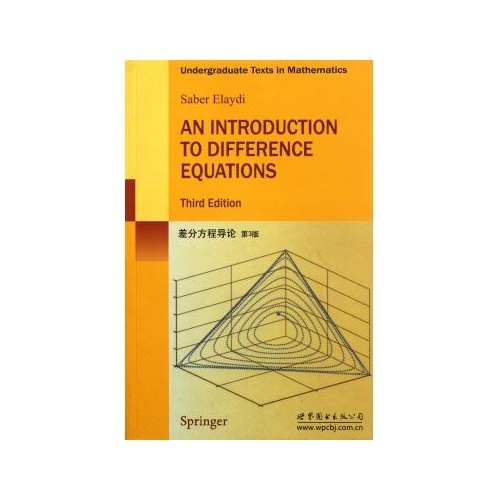《差分方程導論》,作者:埃萊迪,《差分方程導論(英文版)(第3版)》是一本學習差分方程的本科生教程。書中將差分方程的經典方法和現代方法有機結合,包括了最新最權威的一手材料,並且在表述上足夠簡潔明了,適合高年級的本科生和研究生使用。
基本介紹
- 書名:差分方程導論
- 原版名稱:an introduction to difference equations(third edition)
- ISBN:9787510033070
- 頁數: 539頁
- 出版社: 世界圖書出版公司
- 出版時間:第1版 (2011年4月1日)
圖書信息,內容簡介,作者簡介,目錄,
圖書信息
平裝: 539頁
正文語種: 英語
開本: 24
isbn: 9787510033070
條形碼: 9787510033070
商品尺寸: 22.2 x 14.6 x 2.4 cm
商品重量: 699 g
品牌: 世界圖書出版公司北京公司
內容簡介
《差分方程導論(英文版)(第3版)》是一本學習差分方程的本科生教程。書中將差分方程的經典方法和現代方法有機結合,包括了最新最權威的一手材料,並且在表述上足夠簡潔明了,適合高年級的本科生和研究生使用。《差分方程導論(英文版)(第3版)》是第三版,這版中包括了更多的證明,圖表和套用,增加了許多新的內容,如,講述高階尺度差分方程的一章;有關一維映射的局部穩定性和全局穩定性的內容;介紹解的漸進思想的一節;levin-may定理的詳細證明以及lapflour-beetle模型的最新結果。讀者對象:數學專業的本科生,研究生和相關的科研人員。
作者簡介
作者:(美國)埃萊迪(SaberElaydi)
目錄
preface to the third edition
preface to the second edition
preface to the first edition
list of symbols
1 dynamics of first-order difference equations
1.1 introduction
1.2 linear first-order difference equations
1.2.1 important special cases
1.3 equilibrium points
1.3.1 the stair step (cobweb) diagrams
1.3.2 the cobweb theorem of economics
1.4 numerical solutions of differential equations
1.4.1 euler's method
1.4.2 a nonstandard scheme
1.5 criterion for the asymptotic stability of equilibrium points
1.6 periodic points and cycles
1.7 the logistic equation and bifurcation
1.7.1 equilibrium points
1.7.2 2-cycles
1.7.3 22-cycles
1.7.4 the bifurcation diagram
1.8 basin of attraction and global stability (optional)
2 linear difference equations of higher order
2.1 difference calculus
2.1.1 the power shift
2.1.2 factorial polynomials
2.1.3 the antidifference operator
2.2 general theory of linear difference equations
2.3 linear homogeneous equations with constant coefficients
2.4 nonhomogeneous equations: methods of undetermind coefficeints
2.4.1 the method of variation of constants (parameters)
2.5 limiting behavior of solutions
2.6 nonlinear equations transformable to linear equations
2.7 applications
2.7.1 propagation of annual plants
2.7.2 gambler's ruin
2.7.3 national income
2.7.4 the transmission of information
3 systems of linear difference equations
3.1 autonomous (time-invariant) systems
3.1.1 the discrete analogue of the putzer algorithm.
3.1.2 the development of the algorithm for an
3.2 the basic theory
3.3 the jordan form: autonomous (time-invariant) systems revisited
3.3.1 diagonalizable matrices
3.3.2 the jordan form
3.3.3 block-diagonal matrices
3.4 linear periodic systems
3.5 applications
3.5.1 markov chains
3.5.2 regular markov chains
3.5.3 absorbing markov chains
3.5.4 a trade model
3.5.5 the heat equation
4 stability theory
4.1 a norm of a matrix
4.2 notions of stability
4.3 stability of linear systems
4.3.1 nonautonomous linear systems
4.3.2 autonomous linear systems
4.4 phase space analysis
4.5 liapunov's direct, or second, method
4.6 stability by linear approximation
4.7 applications
4.7.1 one species with two age classes
4.7.2 host-parasitoid systems
4.7.3 a business cycle model
4.7.4 the nicholson-bailey model
4.7.5 the flour beetle case study
5 higher-order scalar difference equations
5.1 linear scalar equations
5.2 sufficient conditions for stability
5.3 stability via linearization
5.4 global stability of nonlinear equations
5.5 applications
5.5.1 flour beetles
5.5.2 a mosquito model
6 the z-transform method and volterra difference equations
6.1 definitions and examples
6.1.1 properties of the z-transform
6.2 the inverse z-transform and solutions of difference equations
6.2.1 the power series method
6.2.2 the partial fractions method
6.2.3 the inversion integral method
6.3 volterra difference equations of convolution type: the scalar case
6.4 explicit criteria for stability of volterra equations
6.5 volterra systems
6.6 a variation of constants formula
6.7 the z-transform versus the laplace transform
7 oscillation theory
7.1 three-term difference equations
7.2 self-adjoint second-order equations
7.3 nonlinear difference equations
8 asymptotic behavior of difference equations
8.1 tools of approximation
8.2 poincare's theorem
8.2.1 infinite products and perron's example
8.3 asymptotically diagonal systems
8.4. high-order difference equations
8.5 second-order difference equations
8.5.1 a generalization of the poincare-perron theorem.
8.6 birkhoff's theorem
8.7 nonlinear difference equations
8.8 extensions of the poincare and perron theorems
8.8.1 an extension of perron's second theorem
8.8.2 poincare's theorem revisited
9 applications to continued fractions and orthogonal polynomials
9.1 continued fractions: fundamental recurrence formula
9.2 convergence of continued fractions
9.3 continued fractions and infinite series
9.4 classical orthogonal polynomials
9.5 the fundamental recurrence formula for orthogonal polynomials
9.6 minimal solutions, continued fractions, and orthogonal polynomials
10 control theory
10.1 introduction
10.1.1 discrete equivalents for continuous systems
10.2 controllability
10.2.1 controllability canonical forms
10.30bservability
10.3.10bservability canonical forms
10.4 stabilization by state feedback (design via pole placement)
10.4.1 stabilization of nonlinear systems by feedback
10.5 observers
10.5.1 eigenvalue separation theorem
a stability of nonhyperboli fixed points of maps on the real line
a.1 local stability of nonoscillatory nonhyperbolic maps
a.2 local stability of oscillatory nonhyperbolic maps
a.2.1 results with g(x)
b the vandermonde matrix
c stability of nondifferentiable maps
d stable manifold and the hartman-grobman-cushing theorems
d.1 the stable manifold theorem
d.2 the hartman-grobman-cushing theorem
e the levin-may theorem
f classical orthogonal polynomials
g identities and formulas
answers and hints to selected problems
maple programs
references
index

